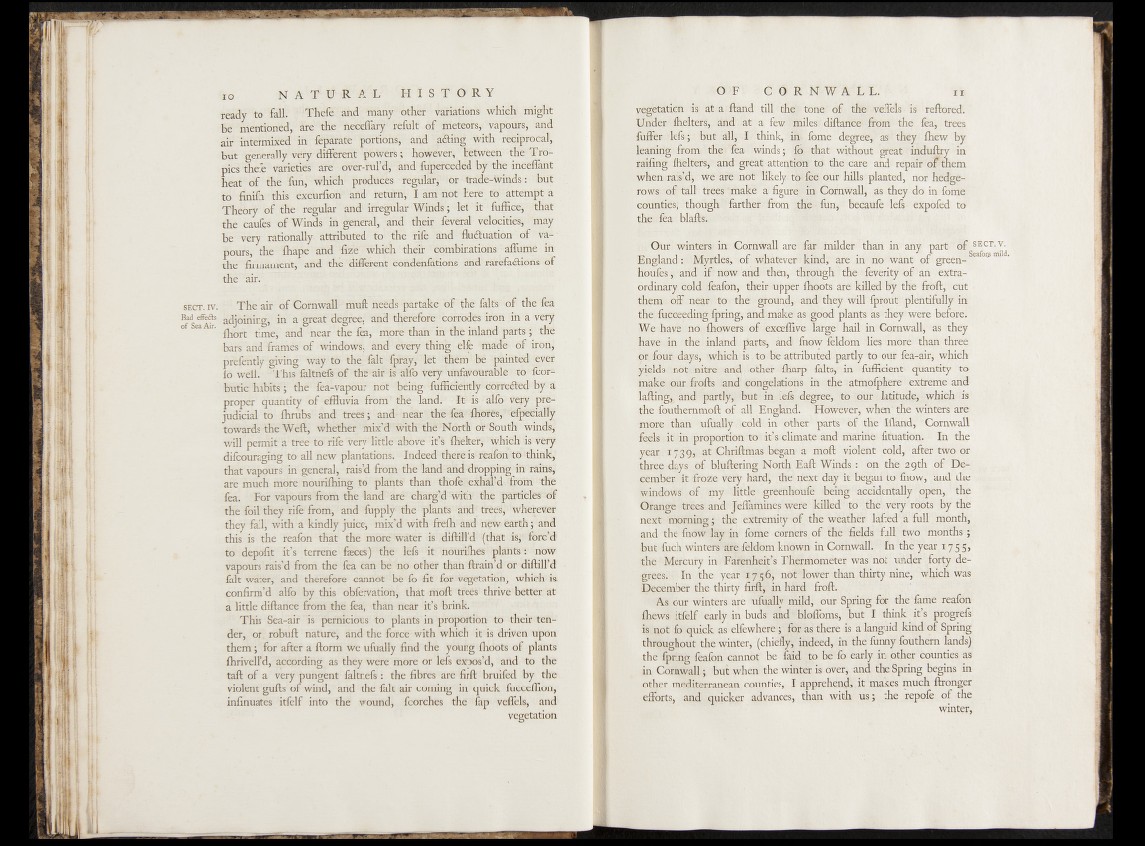
SECT. IV.
Bad effeâs
of Sea Air.
ready to fall. ‘ ' *Thefe and many' other- Variations whiek might
Bé mentioned, àre the neceffary' tefultf- of'sriefoors»* vapours, and
air intermixed ih feparate portions, and a&ihg with reh^rocâl1,
but generally very different pbwers ; hóvféver, Between -thé' Tropics
thefe varieties are over-tul’d, and fuperceded by the incëffâht
heat of the fun, which produces regular; or; trade-winds : büt
to finifh this excurfion1 and retirin', I am-nöt here tb;'attempt a
Theory of the regular and' irregular Winds ; let it \ fuffice, 'that
the caufes of Winds in general, and their feveral velocities, - may
te very rationally attributed to the rife and ’fluétu&tion df 'ra1 '
pours, the Ihape and fire which thefr coinbinations ■ afîùme in
the firmament, and the different condenfations and; rÉ'efaétions öf
the air.
• The air of Gomwallr müft tieëds partake o f the falls'of die fea
adjoining, in a great degree,- arid therefore corrodes iron.in a-very
fhdrt time, and near the fen, rifore'than in the inland parts ; tffè
bars arid frames of windows, ànd every thing elfe ^rha'de d fltên j
prefently giving way to the_ fait fpray, let (öfèriri be 'jointed levé#
fo well. This feltnefs o f thë^âir is alfo véiy’iM^ókröBlê^m^f®^
butic habits ; the Tea-vapour
proper qumtity o f effluvia fronr the land. It- is -'alfo' vejy.
judicial to fhrubs and trees ; and^;né^\phe^S^;tf®êS,f%f^éiâÉ^
towards the Weft, \vh^er ' riiixd,r^itH‘tHè^Nörfh c^fSbu¥h! winds)
will permit a tree to rife Very littleribove :it’§ {belter,- which is very
difcouraging to all new plantations. - Indeed-tiiere issrêafön-!tÖ*thiök,‘
that vapours in general, rais’d from the land arid" dropping‘irirains,
are much more nourilhing to plants than thofe exhafd-jfrorn ‘the
fea. For vapours from the land are charg’d with* the particles'or
the foil they rife from, and fupply the plants |®dy tïèes,1 Wherever
they fall, with a kindly juice, mix’d with frëfh and nçw- earth 5 and
this is the reafon that the more water is diftill’d (that is, forc’d
to depofit it’s terrene fæces) the lefs it nóurifhes plants : now
vapours rais’d from the fea can be no other than ftrain’d or diftill’d
fait water, and therefore cannot be fo fit for vegetation, which is,
confirm’d alfo by this obfervation, that riloft trees thrive better at
a little diftance from the fea, than near it’s brink.
This Sea-air is pernicious to plants in proportion to their tender,
or robuft nature, and the force with which it is driven upon
them ; for after a ftorm we ufiially find the young {hoots of plants
fhrivell’d, according as they were more or lefs expos’d, and to the
taft of a very pungent feltnefs : the fibres are firft bruifed by the
violent gulls of wind, and the fait air coming in quick fucceffion,
infinuates itfelf into the wound, fcorches the fap veffels, and
vegetation
vegetation tiar at a.'Hand t&f the?t tone of the yiflels is reflated.
llriHen {belter^, and at a fevfe'finiles' diflatfee from the fea, trees
fuffer llefrij * but all, I think, in- fome degrefep as; they fhew by
leaning1 frbifrdthei’Iea^l'ivinds; fo that without gfeat induftry in
raffing {heifers'/- and great attention td the care and repair orthem
whensrais-’d ,' we* ^b"nOT^nkely^ tO-fed.Our hills planted, nor hedge-
roVts.tofr tali' ttew^ihake 'af figufqglui Cornwall; as they do in foifre
countiCsj thoii'ght'farther,'from ,the», fun,' becaufe left expofed to
then fea blaftsv*»-''
sr Our wintersjjirr Cornwall are 5 Jkr milder thari in ariy part- 'oft sect.v.
England: Myrtles, of xrihatevemkind,' aite fthno^want- ©TgreeiP
houfes js and ifjnow artd^then, tSfci&gh '"thoTdveritybfran extraordinary
eolditfeafon, their upper {hoots are' killed by the froft, cut <
thenaw-off ne|fiE to< the* ground, andrthey wSl fpfout; plentifully hi
the- fucceeding fpring, andimake^as/.good plants as they’«were before.
We have: no. fliQwers offexCeMve large hail in Cornwall, as they
have;, in the , inland parts, in d fhow felddm difeS'ihforef'than three
ot four days, /which is, to be attributed partly to our lea-air, which
yields not nitre and 'other- fliarp felts,* in fuffident* quantity to
make our frofts and jeongelations in the-atmofphcre i extreme and
lafting^ and partlyr but in lefe degree, to our latitude, which is
the fouthemmoft of all Englahcu However, when^the winters are
more than ' uftiaflly JicoldJ in 'oilierJ' parts ’ bf the Ifland, “Cornwall
feels ititin proportion to tit’s climate and iiiarme fitiiatioft. In the
year. 1,7-39,;-at Chriftmas began a moft violent cold, after two or
three days of bluftering North Eaft Winds : on the 29th o f December
it froze vti'y hard, the riext day it begari to fhow, and the
windows' of my ‘ little< greetihoufe being ’accidentally open, the
Orange -trees and Jeffamines were killed .to the very roots by the
neift' morning; the extremity o f the weather lafted;a full month,
ant] the fndw lay fottie cornersto f th e ’fields full two months ;
but ftich winters '&e feldom known in Cornwall. In the year 1755,
the-Mercury in| Fai^nheit’s Tfi^mometer w4s?n6t urider fopy degrees.
In the year'll 7^6, nbf^lbwer than thirty nine, which -was
December the thirty fiift, in h^rd froft. ,
As our winters are tatiklly mild, our Spring for the feme reafon
fhews itfelf early in buds and ’ blofloms, but I think it s progrefs
is not fo quick as elfewhere ; for as there js a languid , kind o f Spring
throughout the winter, (chieflyy indeed, in the funny fouthem lands)
the fpring feafon cannot be laid to be fo early in other counties as
in Cornwall; but when the winter is over, and the Spring begins in
other mediterranean counties, I apprehend,jit makes much ftronger
efforts, and quicker advances, than with us; the repofe of the
winter,